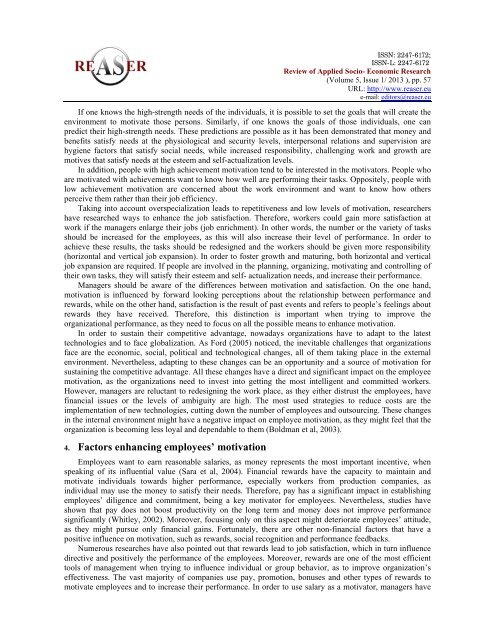new characteristics of inequalities in the information society and ...
new characteristics of inequalities in the information society and ...
new characteristics of inequalities in the information society and ...
You also want an ePaper? Increase the reach of your titles
YUMPU automatically turns print PDFs into web optimized ePapers that Google loves.
ISSN: 2247-6172;<br />
ISSN-L: 2247-6172<br />
Review <strong>of</strong> Applied Socio- Economic Research<br />
(Volume 5, Issue 1/ 2013 ), pp. 57<br />
URL: http://www.reaser.eu<br />
e-mail: editors@reaser.eu<br />
If one knows <strong>the</strong> high-strength needs <strong>of</strong> <strong>the</strong> <strong>in</strong>dividuals, it is possible to set <strong>the</strong> goals that will create <strong>the</strong><br />
environment to motivate those persons. Similarly, if one knows <strong>the</strong> goals <strong>of</strong> those <strong>in</strong>dividuals, one can<br />
predict <strong>the</strong>ir high-strength needs. These predictions are possible as it has been demonstrated that money <strong>and</strong><br />
benefits satisfy needs at <strong>the</strong> physiological <strong>and</strong> security levels, <strong>in</strong>terpersonal relations <strong>and</strong> supervision are<br />
hygiene factors that satisfy social needs, while <strong>in</strong>creased responsibility, challeng<strong>in</strong>g work <strong>and</strong> growth are<br />
motives that satisfy needs at <strong>the</strong> esteem <strong>and</strong> self-actualization levels.<br />
In addition, people with high achievement motivation tend to be <strong>in</strong>terested <strong>in</strong> <strong>the</strong> motivators. People who<br />
are motivated with achievements want to know how well are perform<strong>in</strong>g <strong>the</strong>ir tasks. Oppositely, people with<br />
low achievement motivation are concerned about <strong>the</strong> work environment <strong>and</strong> want to know how o<strong>the</strong>rs<br />
perceive <strong>the</strong>m ra<strong>the</strong>r than <strong>the</strong>ir job efficiency.<br />
Tak<strong>in</strong>g <strong>in</strong>to account overspecialization leads to repetitiveness <strong>and</strong> low levels <strong>of</strong> motivation, researchers<br />
have researched ways to enhance <strong>the</strong> job satisfaction. Therefore, workers could ga<strong>in</strong> more satisfaction at<br />
work if <strong>the</strong> managers enlarge <strong>the</strong>ir jobs (job enrichment). In o<strong>the</strong>r words, <strong>the</strong> number or <strong>the</strong> variety <strong>of</strong> tasks<br />
should be <strong>in</strong>creased for <strong>the</strong> employees, as this will also <strong>in</strong>crease <strong>the</strong>ir level <strong>of</strong> performance. In order to<br />
achieve <strong>the</strong>se results, <strong>the</strong> tasks should be redesigned <strong>and</strong> <strong>the</strong> workers should be given more responsibility<br />
(horizontal <strong>and</strong> vertical job expansion). In order to foster growth <strong>and</strong> matur<strong>in</strong>g, both horizontal <strong>and</strong> vertical<br />
job expansion are required. If people are <strong>in</strong>volved <strong>in</strong> <strong>the</strong> plann<strong>in</strong>g, organiz<strong>in</strong>g, motivat<strong>in</strong>g <strong>and</strong> controll<strong>in</strong>g <strong>of</strong><br />
<strong>the</strong>ir own tasks, <strong>the</strong>y will satisfy <strong>the</strong>ir esteem <strong>and</strong> self- actualization needs, <strong>and</strong> <strong>in</strong>crease <strong>the</strong>ir performance.<br />
Managers should be aware <strong>of</strong> <strong>the</strong> differences between motivation <strong>and</strong> satisfaction. On <strong>the</strong> one h<strong>and</strong>,<br />
motivation is <strong>in</strong>fluenced by forward look<strong>in</strong>g perceptions about <strong>the</strong> relationship between performance <strong>and</strong><br />
rewards, while on <strong>the</strong> o<strong>the</strong>r h<strong>and</strong>, satisfaction is <strong>the</strong> result <strong>of</strong> past events <strong>and</strong> refers to people’s feel<strong>in</strong>gs about<br />
rewards <strong>the</strong>y have received. Therefore, this dist<strong>in</strong>ction is important when try<strong>in</strong>g to improve <strong>the</strong><br />
organizational performance, as <strong>the</strong>y need to focus on all <strong>the</strong> possible means to enhance motivation.<br />
In order to susta<strong>in</strong> <strong>the</strong>ir competitive advantage, nowadays organizations have to adapt to <strong>the</strong> latest<br />
technologies <strong>and</strong> to face globalization. As Ford (2005) noticed, <strong>the</strong> <strong>in</strong>evitable challenges that organizations<br />
face are <strong>the</strong> economic, social, political <strong>and</strong> technological changes, all <strong>of</strong> <strong>the</strong>m tak<strong>in</strong>g place <strong>in</strong> <strong>the</strong> external<br />
environment. Never<strong>the</strong>less, adapt<strong>in</strong>g to <strong>the</strong>se changes can be an opportunity <strong>and</strong> a source <strong>of</strong> motivation for<br />
susta<strong>in</strong><strong>in</strong>g <strong>the</strong> competitive advantage. All <strong>the</strong>se changes have a direct <strong>and</strong> significant impact on <strong>the</strong> employee<br />
motivation, as <strong>the</strong> organizations need to <strong>in</strong>vest <strong>in</strong>to gett<strong>in</strong>g <strong>the</strong> most <strong>in</strong>telligent <strong>and</strong> committed workers.<br />
However, managers are reluctant to redesign<strong>in</strong>g <strong>the</strong> work place, as <strong>the</strong>y ei<strong>the</strong>r distrust <strong>the</strong> employees, have<br />
f<strong>in</strong>ancial issues or <strong>the</strong> levels <strong>of</strong> ambiguity are high. The most used strategies to reduce costs are <strong>the</strong><br />
implementation <strong>of</strong> <strong>new</strong> technologies, cutt<strong>in</strong>g down <strong>the</strong> number <strong>of</strong> employees <strong>and</strong> outsourc<strong>in</strong>g. These changes<br />
<strong>in</strong> <strong>the</strong> <strong>in</strong>ternal environment might have a negative impact on employee motivation, as <strong>the</strong>y might feel that <strong>the</strong><br />
organization is becom<strong>in</strong>g less loyal <strong>and</strong> dependable to <strong>the</strong>m (Boldman et al, 2003).<br />
4. Factors enhanc<strong>in</strong>g employees’ motivation<br />
Employees want to earn reasonable salaries, as money represents <strong>the</strong> most important <strong>in</strong>centive, when<br />
speak<strong>in</strong>g <strong>of</strong> its <strong>in</strong>fluential value (Sara et al, 2004). F<strong>in</strong>ancial rewards have <strong>the</strong> capacity to ma<strong>in</strong>ta<strong>in</strong> <strong>and</strong><br />
motivate <strong>in</strong>dividuals towards higher performance, especially workers from production companies, as<br />
<strong>in</strong>dividual may use <strong>the</strong> money to satisfy <strong>the</strong>ir needs. Therefore, pay has a significant impact <strong>in</strong> establish<strong>in</strong>g<br />
employees’ diligence <strong>and</strong> commitment, be<strong>in</strong>g a key motivator for employees. Never<strong>the</strong>less, studies have<br />
shown that pay does not boost productivity on <strong>the</strong> long term <strong>and</strong> money does not improve performance<br />
significantly (Whitley, 2002). Moreover, focus<strong>in</strong>g only on this aspect might deteriorate employees’ attitude,<br />
as <strong>the</strong>y might pursue only f<strong>in</strong>ancial ga<strong>in</strong>s. Fortunately, <strong>the</strong>re are o<strong>the</strong>r non-f<strong>in</strong>ancial factors that have a<br />
positive <strong>in</strong>fluence on motivation, such as rewards, social recognition <strong>and</strong> performance feedbacks.<br />
Numerous researches have also po<strong>in</strong>ted out that rewards lead to job satisfaction, which <strong>in</strong> turn <strong>in</strong>fluence<br />
directive <strong>and</strong> positively <strong>the</strong> performance <strong>of</strong> <strong>the</strong> employees. Moreover, rewards are one <strong>of</strong> <strong>the</strong> most efficient<br />
tools <strong>of</strong> management when try<strong>in</strong>g to <strong>in</strong>fluence <strong>in</strong>dividual or group behavior, as to improve organization’s<br />
effectiveness. The vast majority <strong>of</strong> companies use pay, promotion, bonuses <strong>and</strong> o<strong>the</strong>r types <strong>of</strong> rewards to<br />
motivate employees <strong>and</strong> to <strong>in</strong>crease <strong>the</strong>ir performance. In order to use salary as a motivator, managers have








